| |
|
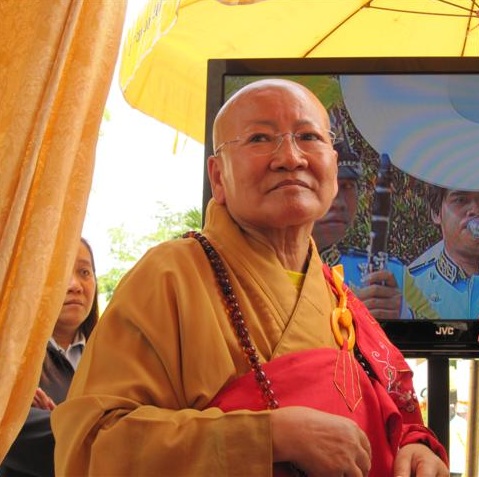
|
|
|
|
This woman named Shi Kuang Seng, whom everyone refers to as Great Master, reigns with tremendous energy, charisma and mystical power. She is of Chinese/Thai background, her round face smooth, her bald head giving her an androgynous look. Short, substantial, with bright black eyes behind rimless glasses, she beams so much warmth that being in the room with her is like receiving the rays of a giant battery. She had been a successful businesswoman, a wife and mother, before taking the robes of a monastic, and remains a kind of spiritual entrepreneur capable of amassing the funds to build the gigantic Kwan Yin stupa and bring together in its 21 stories the largest collection of Buddhist art in the world.
|
| |
|
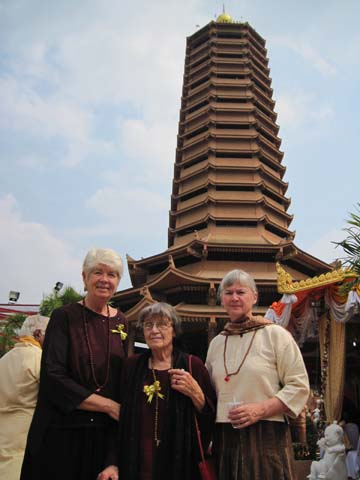
|
| |
|
Ruth Denison, my Buddhist teacher from the Mojave Desert, who accompanied me to Thailand for the ceremonies, drew attention for being the oldest person here and a pioneer of American Buddhism. Often the Great Master invited us into her air-conditioned office just inside the temple entrance to offer us coffee or tea and Thai pastries. While she speaks almost no English, she is tremendously gracious and welcoming, hugging newcomers, sitting us down for treats, conferring gifts like a string of fresh-water pearls with a gold Kwan Yin medal attached.
|
| |
|
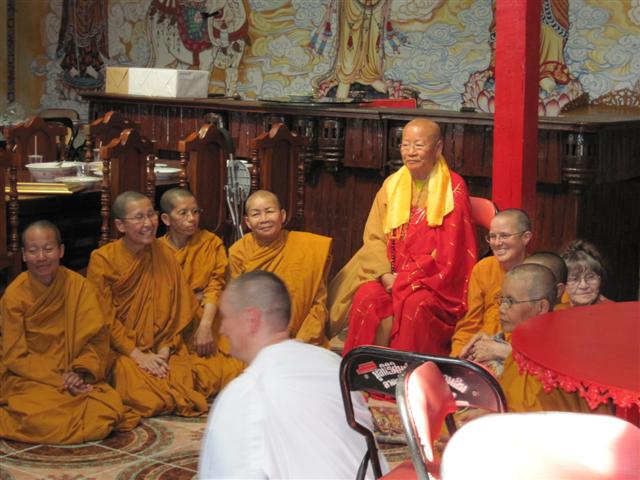
|
| |
|
In Thailand where the full ordination of women into the Theravada Buddhist lineage is not allowed, the Great Master (herself a Mahayana fully ordained nun and therefore not under the jurisdiction of the Thai Theravada Buddhist powers-that-be) has consistently supported the courageous Thai and Western nuns who went to Sri Lanka to ordain and came home to a hostile environment. She has sheltered them in her temple, and at the ceremony to inaugurate the stupa, attended by government dignitaries and senior monks, she made sure the women in robes were seated at the front and treated with as much deference as the monks.
|
| |
|
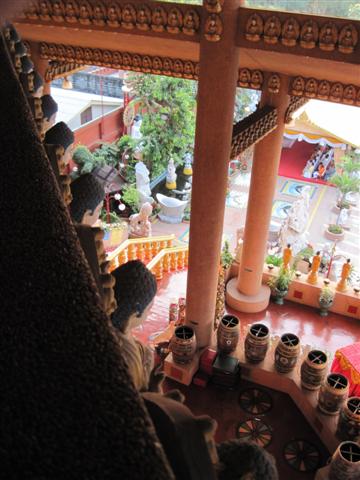
|
| |
|
Before the ceremony began, I stood halfway up the newly opened pagoda, its walls thick with Buddhist paintings and sculptures and assorted kitsch, as well as many pictures of the Thai royal family. Up on the tenth floor, I enjoyed a stunning view of the rooftops of Bangkok. Looking down from my pagoda balcony into the spacious temple courtyard, elegantly decorated with orange and white bunting, statues, potted trees, tents to keep off the sun, I saw hundreds of people in formal suits and long dresses, a sea of yellow-robed monks, and a pond of nuns, a clump of foreigners from India and the West, several marching bands, soldiers and police, and the covered, carpeted area where the Princess would bestow the honors upon us.
|
| |
|
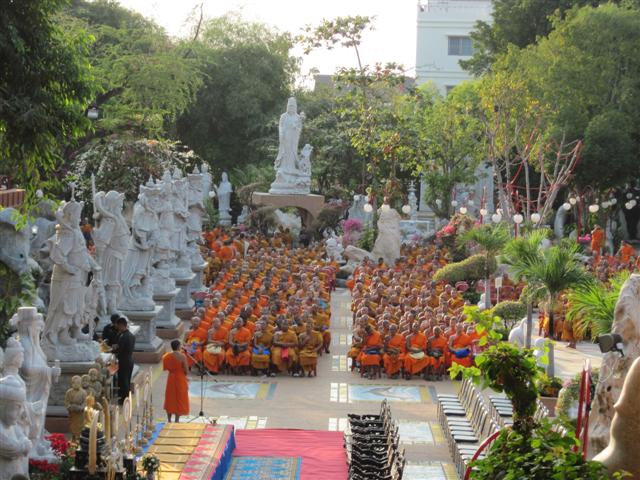
|
| |
|
Down in the courtyard, I joined the groups of people to be honored, where we waited, seated in our particular tents. Soon we were called to the Princess’s tent for a rehearsal, learning just how to bow and receive the plaque and then walk backwards at a 45-degree angle to allow the next person to approach. I hoped I would not trip on my long borrowed skirt.
Then more waiting. The Thais, decorous and patient, sat quietly for two hours; Ruth Denison and I and the other foreign guests sat with them. Finally the Princess arrived, getting out of a car outside the gates of the temple to meet the Great Master and the stream of beautifully dressed Thai people who greeted her. I was told that the Princess and the Great Master are fast friends who would soon be collaborating on the building of a hospital for cancer patients.
The Princess is a woman of substantial accomplishment. The youngest of the Thai king’s four children, she is a 52-year-old woman with a doctorate in chemistry who teaches and carries on research in her field, and was awarded the UNESCO Einstein medal for her efforts in promoting scientific collaboration. She is also raising two daughters from her first marriage.
Here at the temple, the Princess, wearing an elegant ankle-length fitted dress, came smiling into the courtyard. With her long black hair and slender body, she looked decades younger than her age. I was stunned to see that her attendant, almost as gorgeously dressed as she, made the trek into the temple on her knees. At various points in the ceremony that followed, others in the entourage, even the Princess’s husband, had to walk on their knees. I knew the strict rule that one cannot stand taller than the royal person, but my egalitarian American sensibility was unhinged a bit by seeing what that meant in practice.
|
| |
|
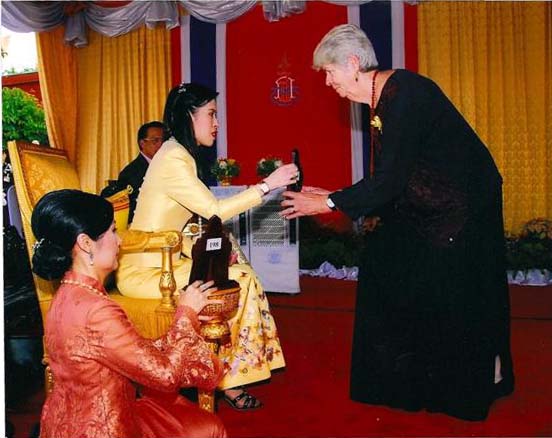
|
| |
|
Finally the moment came when we foreigners were called up to receive our “honors.” Ruth Denison preceded me, and although she is 87 years old, she managed to move gracefully through the moment. When my turn came, I walked toward the seated Princess, did my little dip of the knee and held out my hands for the plaque. The Princess, resplendent in her orange-hued silk dress, stared past my left ear as she handed me the plaque. I was discomfited, imagining that we would have eye contact, that she might even say something to me. Nope. Not a chance. I took three steps backwards as directed, stayed on my feet, and breathed a sigh of relief.
My wooden plaque, with a copper replica of the stupa and script honoring me for “Peace-building & Meritorious Deeds Performed unto Humanity,”� was signed by Great Master Shi Kuang Seng.
I had been invited, I knew, because of the work I’ve done on behalf of women in Buddhism and because of my book on Kwan Yin. As with the Outstanding Women in Buddhism awards in Bangkok in 2006, the major excitement for me was meeting my fellow honorees, some of whom made me feel humble in comparison. On my left sat an American Zen priest who lives in Phnom Penh, Cambodia, where she runs a project to care for AIDS patients. On the other side of me sat an Indian man who has dedicated his life to providing care and corrective surgery for impoverished post-polio patients in India. These people, from my perspective, are living, walking bodhisattvas.
|
| |
|
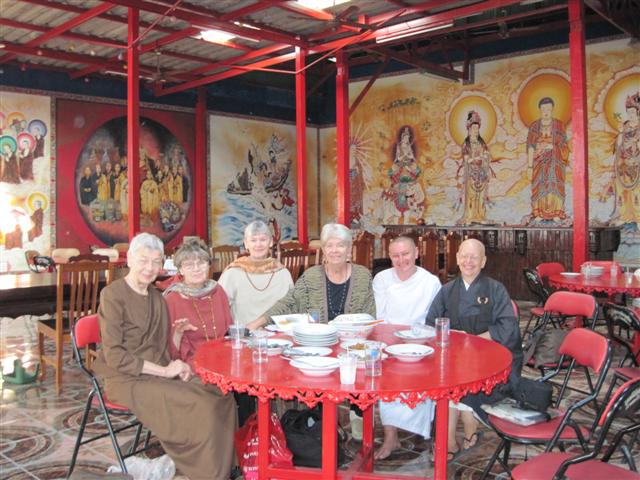
To my far left, the Zen priest from Cambodia, Beth Goldring.
|
| |
|
The ceremony in the courtyard seemed to be winding down as the Princess presented the last of the awards. (More than a hundred people were honored, most of them Thai dignitaries.) But then something unexpected happened. Princess Chulabhorn accompanied the Great Master up into the pagoda. We watched on video screens as she sat down at a Chinese stringed instrument called a gu-jueng—a long Koto-like instrument—and began to play classical music. Next to me Ruth chuckled. “Well, that’s unheard of,” she whispered, “—a ‘Royal’ entertaining commoners.” We settled in to listen to the clear clean voice of plucked strings, cascades of notes calling up deep-toned answers from the bass. I thought that the Princess would play just one short piece as a token contribution, but she paused after the first one and then began a second. Thais and foreigners, we sat mesmerized, watching as the Princess leaned over her instrument and entered the music with formidable precision and passion. She performed a small concert for us—three long difficult pieces delivered with great heart.
Later, in the spacious courtyard, a thousand Buddhist monks chanted a deep steady sound, with unexpected melodies like the ripples and gentle waves of an ocean.
|
| |
|
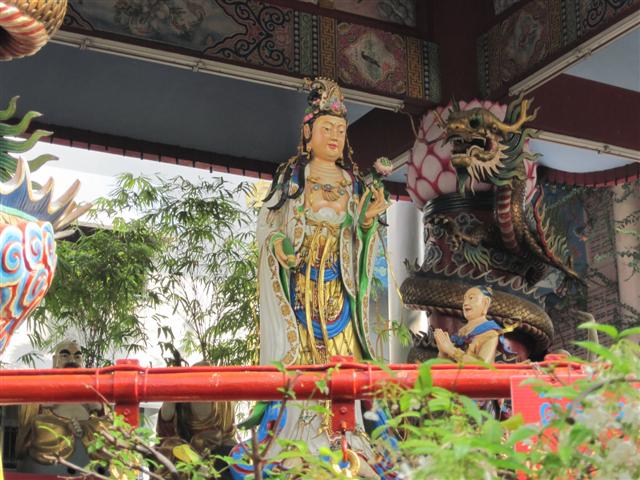
|
| |
|
For the next two weeks I spent each day at the busy temple, where people came to pray and make offerings, to honor deceased relatives, to eat a meal and perhaps pet the small rabbits who could be seen hopping under the tables in the eating area. The Great Master’s son and his wife, who are the directors of the temple, were often present, along with a staff of nuns and volunteers doing the work of running a large organization. Small boys, children of the kitchen workers, ran and played among the tables, and a docile girl baby sat in a playpen. Two female lepers placed themselves each day inside a temple doorway to beg. Except for their deformed hands, they looked like any other Thai women; soon we were greeting each other like old friends. Next door rose a hospital established by the Great Master, free to everyone. Rich people came to the temple to give money to the Great Master, poor people came to meditate, pray and eat.
Surrounded by so much magnificence, in awe of the Great Master’s ability to manifest on the material plane due to her connections with Thai royalty and the upper classes, including some extremely wealthy Chinese businessmen, I was at one moment admiring, at the next uncomfortable. Having done my Buddhist practice in the simple surroundings of American Vipassana centers or austere Zen centers, I wondered how Buddhist it was to amass wealth, create elaborate buildings, commission whole gardens full of marble statues of Kwan Yin, place tall golden images of the Bodhisattva of Compassion on the roofs of the buildings. “Is this what the Buddha intended?”� I asked my American nun friend who has lived in Thailand for ten years. “You’re in Asia now,”� she replied. “The Great Master has been guided by dreams and visions to create these temples. Yes, the conspicuous wealth is here, but look at the good work the Great Master does in the world, how she uses the wealth to benefit people and offer opportunities for practice and devotion. ”
|
| |
|
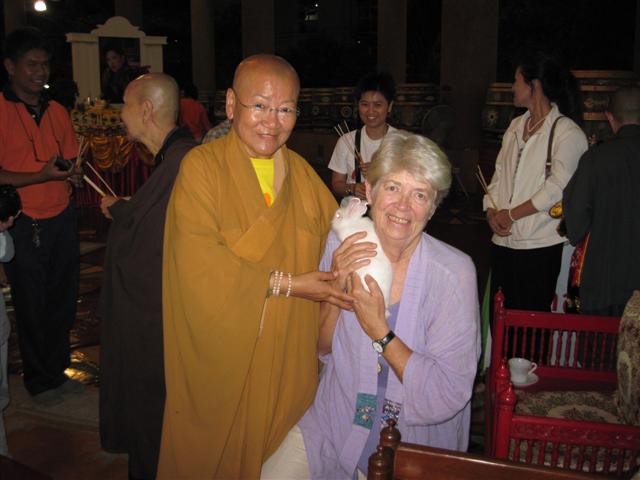
|
| |
|
Each day for a month the ceremonies went on, with chanting by hundreds of monks every afternoon and a Dharma talk in the evening. For part of this time I stayed in an elegant upper guest room with wide Chinese beds inlaid with mother of pearl. A gigantic green dragon curling off the rooftop glared through the window at me. Dragons have great significance for Thai and Chinese people, representing strength as well as transformative and protective powers.
I knew that on a day soon to arrive, I would be giving the evening Dharma talk at the pagoda. The prospect set up a twanging in my nerves. On the open-air platform of the first floor of the pagoda where the talks took place, four enormous golden statues of the thousand-armed Avalokesvara (Kwan Yin) rose, looking out to the four directions. Each evening the Great Master and the speaker sat facing one of the statues, which towered above them, while the audience sat on the floor of the temple, spreading out in both directions. After preliminary chanting, the Great Master, speaking Thai, would introduce the speaker, and the speaker would give her talk, either in Thai or English, after which the Great Master would hold forth, then end the evening by leading a chant and giving out candles and incense.
In the glow of sunset, with the spacious courtyard opening behind, the illuminated tower rising up into the darkening sky, and traffic sounds distant, the scene felt expansive and enormously exposed, as if not only humans but beings from other dimensions must be listening in. Truly an intimidating scene.
|
| |
|
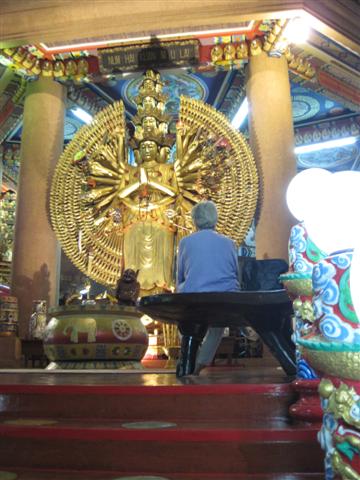
|
| |
|
But finally my evening came. I sat next to the Great Master in her splendid red and yellow robe, and after she introduced me, I picked up the microphone and talked (through a translator who sat on the floor next to me). I told about my own experience with the Celestial Bodhisattva of Compassion Kwan Yin, how I as a westerner had discovered her and come to revere her. I told about the book I had written for her, Discovering Kwan Yin, and led the assembled people in a full-moon guided meditation to connect with Kwan Yin. Then the Great Master instructed me. “Chant! Chant!” So I began to sing the Kwan Yin chant I had learned at the City of 10,000 Buddhas in Talmage, California. “Namo Guan Shih Yin Pu Sa” over and over into the night air. I imagined that the people would sing with me as the melody was not so different from the ones they performed, its words meaning simply “We take refuge in you, Kwan Yin Bodhisattva.”� But no one joined me. My own voice drew a line out into the listening silence, rising and falling until I began to wonder how I might come to a stopping place.
|
| |
|
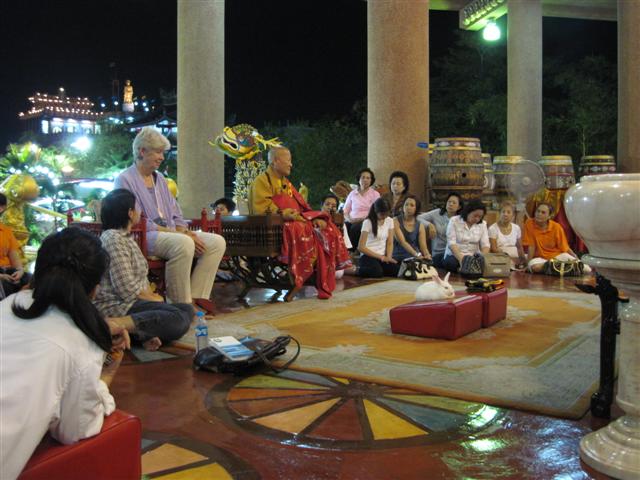
|
| |
|
It was then I heard a strange, high, nasal sound next to me. I fell silent, and turned to look at the Great Master. Her eyes closed, a concentrated expression on her face, she was speaking in that piercing childlike voice. Shivers ran up my spine, as I remembered someone’s telling me that one source of the Great Master’s power is that she functions as a medium. Clearly she was bringing some other entity among us now. Later as she shifted into her regular voice, my translator whispered to me that the Great Master was telling us that there were other dimensions than this one we are aware of, other forces hovering here, just outside our consciousness. Gesturing toward the little rabbit sitting motionless on a cushion before us, she asked, “If these other forces were not at work, how could it be that this rabbit has sat without moving since the afternoon?” All eyes went to the soft white-furred animal on its pillow.
|
| |
|
The evening ended with chant and then everyone thronged around the Great Master, kneeling one by one before her to receive a few small candles and sticks of incense. Often she stroked someone’s head, cupped a cheek, smiling down into reverent eyes. The ritual felt light and celebratory, with everyone enjoying themselves and the Great Master laughing often. There was intimacy in each of her encounters; she seemed to know each of these people, like a mother with her children.
|
| |
|
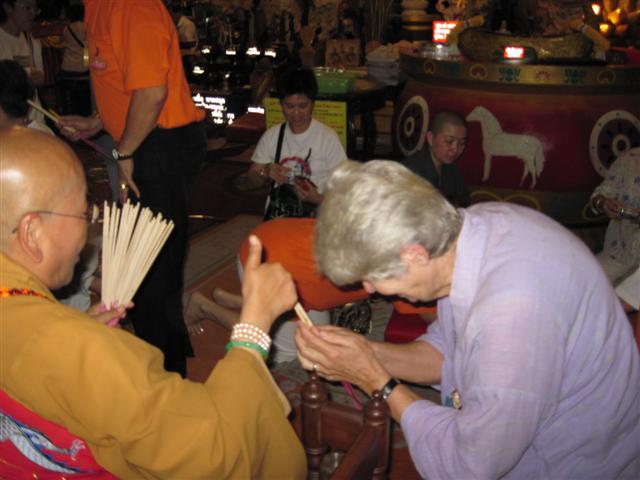
|
| |
|
When it was my turn to kneel before her, she placed the candles and incense in my hands, briefly touched my shoulders, and then gave me the thumbs-up as she grinned at me. �You did well, � her black amused eyes conveyed. And we both began to laugh.
That night as I lay in my bed in the upper room, watched over by the dragon coiling outside my window, I recognized that in a setting like this my idea of Buddhism is challenged and enlarged—particularly in encountering a female Buddhist master of such obvious gifts who is operating in a country where women are routinely dismissed and abused. As an American Buddhist, I need the corrective of places like the Kwan Yin temple and people like Great Master Shi Kuang Seng. Something joyful and expansive stays with me now as I remember the leper women begging in their doorway, the young soldier who stood at a microphone to lead a Pali chant, the mother-and-daughter nun pair who tended the souvenir counter in the temple. I think of them existing in a hub of bright energy, the aura of a big, perhaps enlightened, teacher, a richly empowered Buddhist woman.
|












